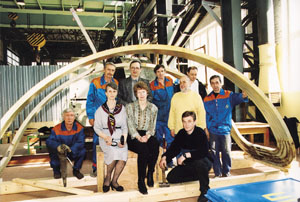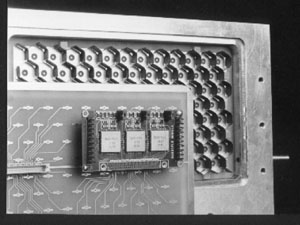While proton-proton collisions will be the principal diet of CERN’s LHC machine, heavy-ion collisions will also be on the menu. The ALICE experiment will be ready and waiting.

The ALICE collaboration of some 900 physicists is preparing a detector to study lead-ion collisions at CERN’s Large Hadron Collider (LHC) starting in 2005. By observing the results of such collisions, ALICE will continue CERN’s pioneering investigations through the phase transition from ordinary nuclear matter to the state of matter as it is believed to have existed when the universe was just a few microseconds old.
The ALICE detector is being built around the existing magnet of the L3 detector, which is currently taking its last data at the Large Electron Positron collider (LEP), CERN’s current flagship accelerator. ALICE has the same Russian-doll structure as most collider detectors, but with the addition of a dedicated spectrometer at one end. This will have the job of reconstructing the particles produced in lead-lead collisions that decay into muons.
The overall design of the muon spectrometer was finalized in 1999, and was the subject of one of the collaboration’s technical design reports (TDRs) – the documents that mark the transition from R&D to production phases for all the LHC’s experiments. A full-scale prototype of the muon spectrometer’s momentum analysing dipole magnet was completed in April. The spectrometer’s sensitive elements, 10 multi-wire proportional chambers with a total of around a million read-out channels, have been the subject of test-beam studies this summer.
Particle tracking
Another of ALICE’s TDRs concerns the experiment’s inner tracking system (ITS). This is the innermost layer of the detector, responsible for tracking emerging particles where their density will be at its highest.
ALICE physicists have been working with colleagues from fellow LHC experiment LHCb to develop silicon pixel chips for the inner two layers of the ITS. The result is a chip with 50 x 425 mm cells; a prototype detector based on this chip is being tested this year. The ITS has six layers, all using silicon technology, and about 10 million digital and 2 million analogue readout channels to digest the huge number of particles produced in LHC lead-ion collisions. The collaboration has opted for a hybrid ITS structure combining sensors, electronics and mechanical support. Beam tests so far have indicated that the ITS should achieve position resolution better than 20 mm.

Surrounding the ITS is the core of the ALICE detector – its time projection chamber (TPC). The TPC is a gas-filled detector with an electric field applied across it. Electrons liberated by ionization of the gas caused by a passing charged particle drift in the electric field and are detected at the end of the chamber. By measuring the arrival time of these electrons, the TPC reconstructs the path of the original charged particles. Several of the TPC’s most crucial elements have been extensively tested over recent years, and its largest element – a gas-filled cylinder made of composite structures similar to those used in space applications – will enter the production phase early next year.
The TPC in turn will be inside a transition radiation detector (TRD) that will be used to identify electrons and positrons. Several physical processes of interest to lead-ion physics give rise to electron-positron pairs. These include pairs directly produced in the initial stages of the collision or pairs produced as the result of the decays of heavier particles. The TRD, in conjunction with the ITS and TPC, will be able to identify the sources of electron pairs. It will work by measuring the radiation emitted when charged particles cross the boundary between two media with different refractive indices.
Special detectors
Unlike a conventional “Russian doll” collider detector, several of ALICE’s subdetectors will cover only a part of the full solid angle surrounding the collisions. Among these are the experiment’s high-momentum particle identification system (HMPID), its photon spectrometer (PHOS) and four detectors designed to measure particles emerging very close to the beam direction – the zero-degree calorimeters (ZDCs), the CASTOR small-angle calorimeter, the photon multiplicity detector (PMD), and a forward-charged particle multiplicity detector (FMD).
A prototype HMPID was put through its paces in 1998 using particles produced when a 350 GeV pion beam from the proton synchrotron struck a beryllium target. This allowed the collaboration to test both the detector’s performance and the pattern-recognition programs that will identify individual particles. That prototype was then shipped to Brookhaven in the US where it is now operational in the STAR detector at the laboratory’s Relativistic Heavy Ion Collider. ALICE, meanwhile, has started construction of its full-scale HMPID detector.
The PHOS will be made of lead tungstate crystals and will sample emerging photons over a limited area. This means that a relatively modest number of 18 000 crystals is needed. These will be supplied from production plants in China and Russia. For comparison, the LHC’s CMS experiment, whose electromagnetic calorimeter is based on the same crystals, will require around 80 000. By summer 2000, ALICE crystal production was getting under way with several hundred crystals having been produced in Russia.
One of the small-angle detector systems will serve primarily for triggering purposes – telling the electronics when an interesting collision has taken place. The ZDCs will be placed about 100 m away on each side of the main ALICE detector to measure the energy carried by particles emerging very close to the beam direction.
The CASTOR calorimeter will be placed about 16 m away from the interaction point on the opposite side to the muon spectrometer. It will have a sandwich structure of quartz fibre planes separated by tungsten plates. CASTOR’s job will be to search for exotic particles.
The FMD will consist of a number of discs, each divided into sensitive pads, placed at varying distances from the interaction point so as to cover the largest possible area. It will count the number of charged particles in the forward region and provide information for the experiment’s trigger.
The PMD will be embedded within the main detector, attached to the magnet return yoke at 5.8 m from the interaction point opposite the muon spectrometer. It will be used primarily with the FMD to measure the ratio of photons to charged particles emerging on an event-by-event basis. This will give ALICE physicists information about event shapes and fluctuations in the forward region. The PMD has a honeycomb geometry, the cells of which are 8 mm deep with a surface of about 1 cm2. Copper walls separate the cells in order to prevent signals from blowing up by confining low-energy electrons to a single cell. A 96-cell prototype has been successfully tested in beams at CERN.
Time of flight
Another critical measurement for ALICE is the time of flight of emerging particles. Conventional time-of-flight detectors use fast scintillator detectors with coarse granularity. For ALICE, where a very fine granularity is required, this would have presented a very costly option and several alternatives were studied.
The one that the collaboration has adopted is multigap resistive plate chambers (MRPCs). These consist of a series of gas-filled gaps separated by high-resistivity plates. A strong electric field across the gaps gives rise to electron avalanches when charged particles pass through the chambers. The design of ALICE’s MRPCs involves optimizing the gap size – a small gap gives a faster response but a large gap gives a stronger signal. Multiple gaps allow for a smaller gap size since the signal can be integrated over several gaps. Extensive tests in 1999 with varying gap size and using different material for the resistive plates gave very encouraging results with time resolution better than 80 ps at more than 95% efficiency – easily competitive with classical scintillator detectors. Further tests aimed at finalizing the detector design are under way.
The ALICE collaboration is currently putting the finishing touches to its last few TDRs. With these completed, the entire detector blueprint will be in place and the collaboration expects its detector to be in full-scale production by the end of the year – right on schedule to be ready for the LHC’s first lead-ion collisions in 2005.







